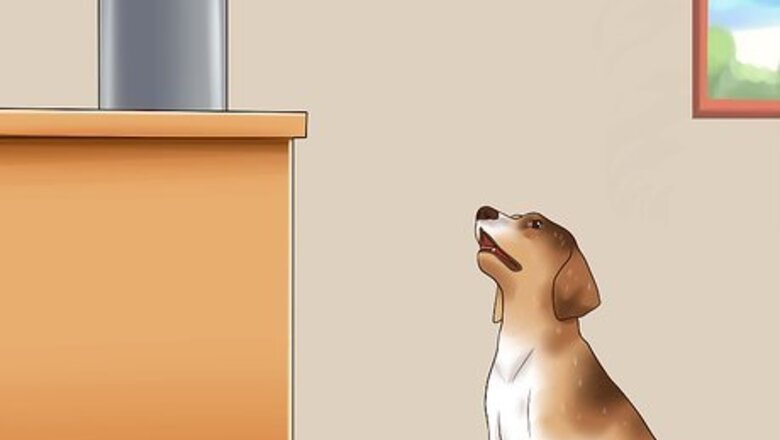
views
X
Research source
Quite obviously, eating out of the garbage can is a very undesirable behavior for your dog. Fortunately, there are a number of different things you can try to keep your dog out of the garbage can.
Making the Garbage can Unattainable or Undesirable
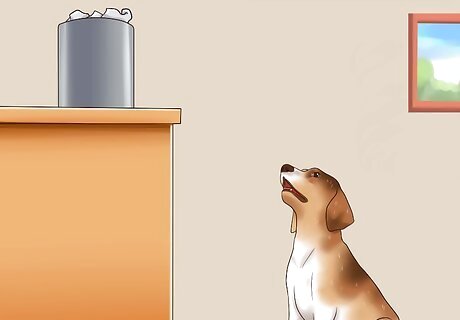
Prevent your dog’s access to the garbage can. There are many ways that you can keep your dog from getting to the garbage can. For example, you can keep the kitchen garbage can in a closed cupboard. However, if your dog has figured out a way to open cupboards, you may need to put childproof latches on the handles. In other rooms of the house, you could try putting small wastebaskets at a height where your dog could not reach them, such as the top of a dresser. You could also restrict his access to entire rooms that have garbage can or wastebaskets by closing doors or using baby gates. Consider using a garbage can with a lid that your dog cannot open. garbage cans with a step mechanism to open the lid would not be good, since your dog could figure out how to use the step. Look at garbage cans from your dog’s perspective to determine which types would be easy or difficult for him to get into.
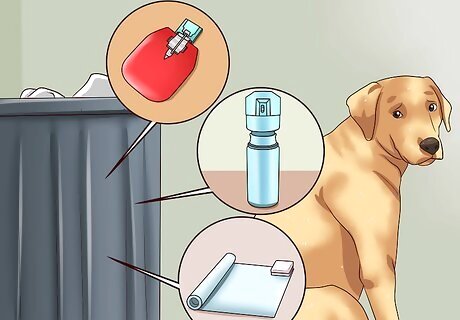
Make the garbage can undesirable. A common way to correct bad behavior is to make that behavior undesirable. Environmental punishment is a way to discourage bad behavior. There are commercially available deterrent devices that you can set up near the garbage can to keep your dog away from it. One device is a mousetrap-like device that will loudly pop up into the air when your dog steps on it. You can also place a motion-activated device near your garbage can that will blow a shot of compressed air when your dog approaches the garbage can. There is also a type of mat that delivers a small shock when your dog steps on it. Environmental punishment is most effective for dogs who have learned to sneak into the trash when their owners are not around. Although environmental punishment does not cause physical injury, it should not be used with dogs who are naturally skittish or anxious. If your dog is skittish, the sudden shock, blast of air, or loud popping noise may make him even more fearful.
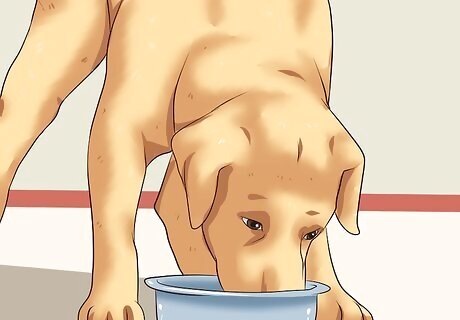
Keep your dog full. Your dog may want to sift through the trash because he is hungry. Feeding him several small meals a day can help keep him full to the point where he won’t feel the need to scavenge for extra food. If your dog is on a diet to lose weight, consider talking with your veterinarian to come up with a feeding schedule that will keep him full but will not cause him to gain weight. If you are away for most of the day and cannot be there to feed him, restricting his access to the garbage can may be easier for you. Be aware that some dogs are not good at knowing when they are full and never stop eating. Don't attempt to feed these dogs until they stop eating or they will become obese.
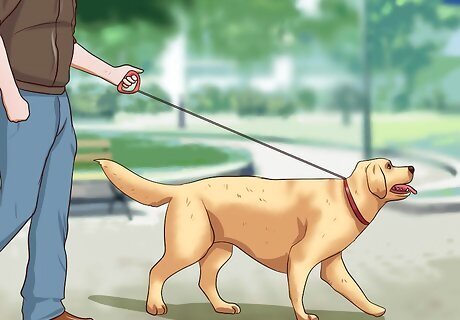
Provide your dog with physical and mental exercise. Even if your dog feels full, he may be tempted to get into the garbage can because he is bored. From your dog’s perspective, the different scents in your garbage can could keep him happily occupied. To keep him from getting bored, make sure that you give him plenty of exercise by taking him on walks and playing with him. If he is well trained, you could also take him to a dog park to let him run around and interact with other dogs. Giving him toys to play with can keep him busy when you are not home.
Teaching Your Dog to ‘Leave It’
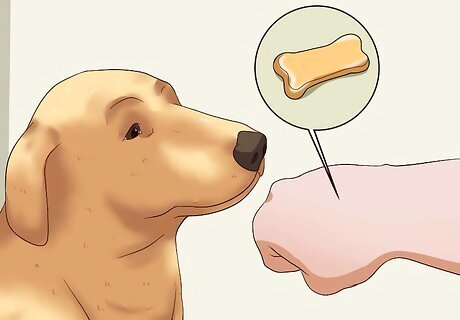
Hold a treat in a closed fist. The ‘leave it’ command teaches your dog to walk away from the garbage can. With the treat in your closed fist, your dog will probably sniff and paw at your hand, and might even bark or whine to get the treat. When he has lost interest in getting the treat—probably after a minute or two— open your fist, immediately say ‘yes,’ and give him the treat. Every three to four times that you practice this, hold your fist open, say ‘yes,’ and give him the treat. You want to teach him that he needs to walk away only when you say ‘leave it.’ Keep practicing this until your dog knows to leave the treat alone when you say ‘leave it.’
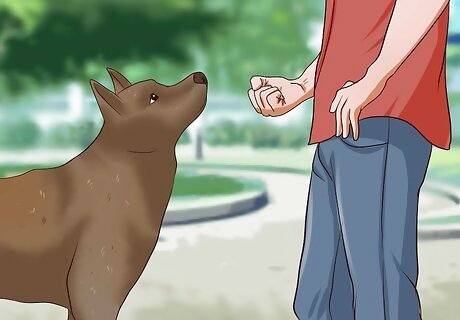
Teach your dog to look at you to get the treat. Hold a treat in your closed fist and say ‘leave it.’ Rather than paw at your hand, your dog will likely look up to you expectantly to wait for you to say ‘yes.’ As soon as he looks up at you, open your fist, immediately say ‘yes,’ and give him the treat. You may need to practice this many times before your dog learns that direct eye contact with you is necessary to earn his treat when you say ‘leave it.’ Looking at you also redirects his attention from whatever he may have been tempted to eat.
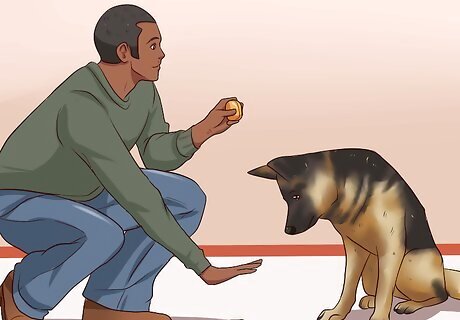
Place a treat on the floor. Choose a different type of treat to place on the floor—it should be one that he likes, but not as much as his favorite treat. The treat on the floor will be the ‘bait.’ When you place the bait on the floor, say ‘leave it’ and closely cover the bait with your hand. Hold his favorite treat in your other hand. When your dog eventually loses interest in getting the bait under your hand, pick the bait up off the floor, immediately say ‘yes,’ and give him his favorite treat. Make sure that he does not eat the bait. If he manages to get to the bait, show him the tastier treat that he could have gotten if he hadn’t eaten the bait. Challenge him by holding your hand up to six inches above the bait. This will test his ability to leave the bait on the floor even when it is in clear sight and easily attainable. Repeat this until he resists the temptation to eat the bait, and instead chooses to look up at you and wait for you to say ‘yes.’
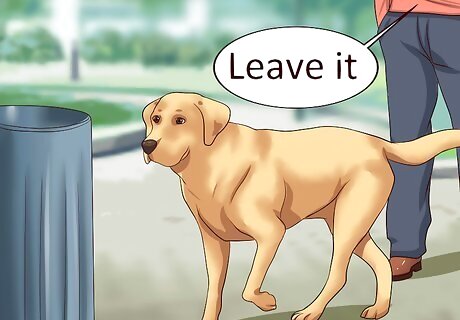
Say ‘Leave it’ when your dog approaches the garbage can. When your dog walks near the garbage can, say ‘leave it.’ By this point in his training, your dog should know to look at you for a reward rather than reach for something that he is not supposed to (in this case, whatever is in the garbage can). Reward him with a treat each time that he turns away from the garbage can and looks at you.
Teaching Your Dog the ‘Off’ Command
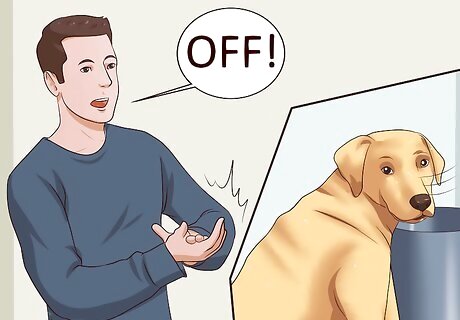
Clap your hands and say ‘off.’ If you catch your dog in the act of sifting through the garbage can, clap your hands and authoritatively say ‘off’ at the same time. Then, gently take him by the collar and move him from the garbage can. It is important to say ‘off’ when you see him going through the garbage can. If you do it after the fact, such as when you see him munching on food that he got from the garbage can, he will be confused as to why you are punishing him. That confusion may lead him to become fearful of you and your punishment. It may take several repetitions of you saying ‘off’ and clapping your hands before your dog learns not to dig through the garbage can.
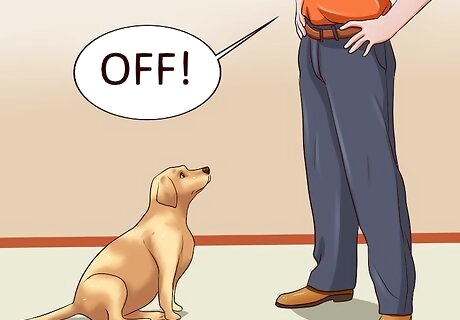
Say ‘off’ without clapping your hands. An alternative way of giving this command is to say ‘off’ and then call him to you. Reward him with a treat when he comes to you. You can think of this as discouraging the bad behavior by distracting him with something more rewarding. You may need to repeat this several times when you see him approaching the garbage can. Eventually, he will learn that walking away from the garbage can is more rewarding than walking towards it.
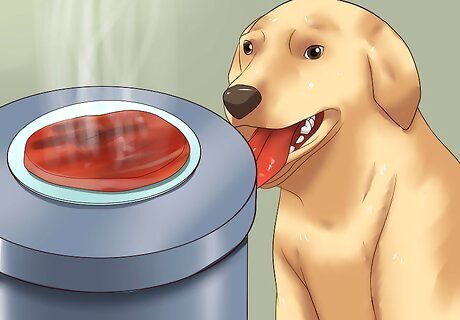
Place a smelly food on top of the garbage can. If you know what type of food he typically likes to scrounge for in the trash, place that food on top of the garbage can. Say ‘off’ and reward him when he comes to you. After several (or many) repetitions, your dog should eventually learn that he should walk from the garbage can, even when something very desirable is in it.


















Comments
0 comment